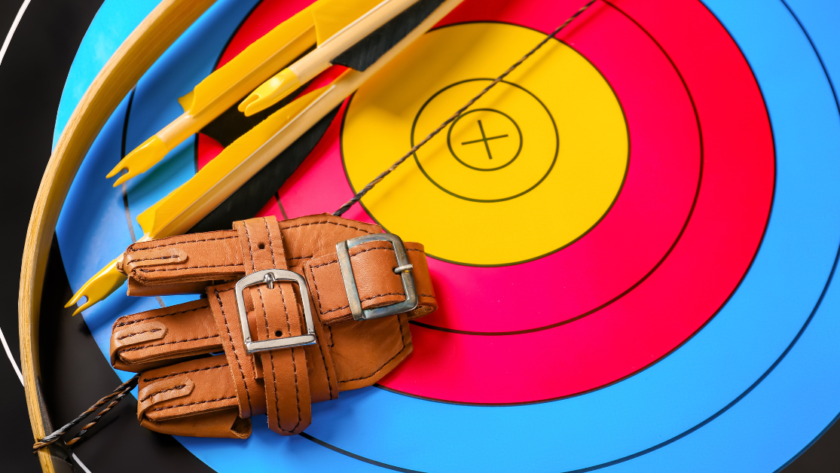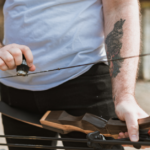As an experienced archer and equipment specialist, I’ve seen firsthand how the right pair of gloves can transform an archer’s performance. Whether you’re just starting out or looking to upgrade your gear, understanding the nuances of archery gloves is crucial for finding the perfect fit.
Understanding Archery Glove Basics
Archery gloves serve two primary purposes: protecting your fingers from the bowstring’s friction and providing a consistent release surface for improved accuracy. The most common design covers three fingers – the index, middle, and ring fingers – which are used to draw and release the string.
Materials Matter
The choice of material significantly impacts a glove’s performance and durability. Leather has long been the traditional material for archery gloves because of it’s natural durability and ability to mold to the archer’s hand over time.
High-quality leather gloves, such as those made from deerskin or cowhide, offer excellent protection and a good feel for the string.
In recent years, modern synthetic materials have gained popularity. These include microfiber and Cordura, which offer consistent performance across various weather conditions and typically require less break-in time compared to leather.
Some archers prefer synthetic gloves for their lightweight feel and quick-drying properties.
Design Considerations
Archery glove designs vary significantly, from minimalist finger tabs to full-hand gloves. Three-finger designs are the most common, striking a balance between protection and dexterity.
Full-hand gloves offer extra protection and warmth, making them popular among hunters and archers who shoot in cold conditions.
One crucial design element is the reinforcement of fingertips. High-quality gloves often feature extra layers of material or specially designed tips to withstand the repeated friction from the bowstring.
Some advanced models even offer replaceable fingertips, extending the life of the glove.
Choosing the Right Fit
Finding the perfect fit is paramount when selecting archery gloves. A well-fitted glove should feel like a second skin, allowing for natural finger movement while providing adequate protection.
Here’s how to confirm you get the right fit:
- Measure your hand: Use a flexible tape measure to decide the circumference of your hand at it’s widest point, typically just below the knuckles.
- Consider finger length: Some manufacturers offer different finger lengths within the same hand size.
If you have particularly long or short fingers, look for gloves that accommodate this.
- Try before you buy: If possible, visit an archery shop to try on different gloves.
Pay attention to how the glove feels when mimicking the drawing motion.
- Check for snugness: The glove should fit snugly around the fingertips but allow for some flexibility at the base of the fingers.
- Assess the wrist strap: Ensure the wrist strap provides a secure fit without cutting off circulation.
Remember, a glove that’s too tight can restrict blood flow and cause discomfort, while one that’s too loose may affect your release consistency.
Overcoming Common Challenges
Even with the best archery gloves, archers may encounter some challenges. Here are some common issues and how to address them:
Reduced Sensitivity
Some archers find that gloves reduce their ability to feel the bowstring, potentially affecting their release technique. To combat this:
- Opt for thinner gloves or those with strategically placed padding
- Consider finger tabs as an choice for increased sensitivity
- Practice regularly with your chosen glove to develop muscle memory
Break-in Period
Leather gloves often need a break-in period to achieve optimal comfort and performance. To speed up this process:
- Wear the gloves around the house to help them conform to your hand shape
- Apply leather conditioner to soften the material
- Use a wooden dowel to gently stretch the finger stalls
Inconsistent Nocking Point
Some archers find that gloves can lead to inconsistent nocking point placement. To maintain consistency:
- Mark your nocking point on the glove with a small dot of nail polish
- Focus on developing a consistent anchor point
- Consider gloves with built-in nocking point indicators
Adapting to Different Scenarios
The best archery gloves should be versatile enough to adapt to various shooting conditions and styles. Here are some tips for adapting your glove choice to different scenarios:
Target Archery vs. Hunting
Target archers often prefer thinner gloves or tabs for most sensitivity, while hunters may opt for full-hand gloves that offer warmth and protection in outdoor conditions.
Seasonal Considerations
In colder months, look for gloves with insulation or consider layering a thin liner glove underneath your regular archery glove. For summer shooting, breathable materials and moisture-wicking properties are essential.
Bow Type
Different bow types may require slight adjustments in glove choice. For example, compound bow shooters might prefer gloves with a smoother release surface, while traditional archers might opt for softer leather for a more natural feel.
Advanced Techniques and Customization
As you progress in your archery skills, you may want to explore advanced techniques and customization options for your gloves:
DIY Modifications
Some archers choose to change their gloves for a truly personalized fit:
- Add extra padding to specific areas for enhanced comfort
- Trim excess material for a sleeker profile
- Create custom stitching patterns for improved grip
Hybrid Designs
Experiment with combining elements of gloves and tabs to create a hybrid design that suits your unique needs. This could involve attaching a tab-like surface to a glove base for increased sensitivity.
Smart Fabrics
Keep an eye on emerging technologies in archery gear. Some manufacturers are exploring smart fabrics that adjust to temperature changes or provide feedback on grip pressure.
Exercises to Enhance Glove Performance
To make the most of your archery gloves, incorporate these exercises into your practice routine:
- Finger strength training: Use hand grippers or stress balls to build finger strength and dexterity.
- Blind nocking drills: Practice nocking arrows with your eyes closed to develop consistent hand placement.
- Release consistency exercises: Focus on maintaining a smooth, consistent release with your gloved hand.
- Weather adaptation: Practice in various weather conditions to understand how your gloves perform in different environments.
- Glove rotation: If you own many pairs, rotate between them to develop adaptability and prevent over-reliance on a single glove.
Top Archery Gloves on the Market
Now that we’ve covered the essentials of archery gloves, let’s look at some of the best options available:
1. Damascus Doeskin Shooting Glove
This classic leather glove is made from soft, supple doeskin leather. It offers excellent protection and sensitivity, making it a favorite among traditional archers.
Pros:
- High-quality leather that molds to your hand
- Excellent durability
- Good balance of protection and sensitivity
Cons:
- Requires a break-in period
- May not be suitable for people who have leather allergies
2. Allen Company Super Comfort Archery Glove
This synthetic glove features a breathable mesh back and reinforced fingertips. It’s an excellent choice for archers who prioritize comfort and quick-drying properties.
Pros:
- Breathable and comfortable
- Quick-drying
- Affordable
Cons:
- May not be as durable as leather options
- Some archers find the synthetic material less sensitive
3. Neet Suede Leather Glove
This suede leather glove offers a good balance of protection and feel. It features an adjustable wrist strap for a secure fit.
Pros:
- Soft suede leather for comfort
- Good protection without sacrificing sensitivity
- Adjustable fit
Cons:
- May wear out faster than full-grain leather options
- Some archers find the finger stalls too long
4. Bearpaw Bodnik Speed Glove
This minimalist glove is designed for speed shooting and offers excellent sensitivity. It’s a favorite among instinctive archers.
Pros:
- Excellent sensitivity
- Minimal design for quick shooting
- Durable construction
Cons:
- Less protection than full-fingered gloves
- May not be suitable for high-draw weight bows
5. ArcheryMax Handmade Leather Three Finger Glove
This handmade leather glove offers excellent craftsmanship and durability. It features reinforced fingertips and an adjustable wrist strap.
Pros:
- High-quality, durable leather
- Reinforced fingertips for longevity
- Customizable fit
Cons:
- Higher price point
- Significant break-in period required
Caring for Your Archery Gloves
Proper care and maintenance can significantly extend the life of your archery gloves. Here are some tips to keep your gloves in top condition:
- Clean regularly: Wipe down your gloves after each use to remove sweat and dirt.
For leather gloves, use a damp cloth and mild soap if needed.
- Condition leather gloves: Apply a leather conditioner every few months to keep the leather supple and prevent cracking.
- Air dry: Always allow your gloves to air dry naturally.
Avoid direct heat sources, which can damage the material.
- Store properly: Keep your gloves in a cool, dry place away from direct sunlight when not in use.
- Rotate gloves: If you have many pairs, rotate their use to prevent excessive wear on a single pair.
- Inspect regularly: Check your gloves for signs of wear, especially around the fingertips and seams.
Address any issues promptly to prevent further damage.
The Future of Archery Gloves
As technology continues to advance, we can expect to see some exciting developments in archery glove design:
- Smart materials: Fabrics that adapt to temperature changes or provide biofeedback on grip pressure and release consistency.
- 3D-printed customization: Gloves tailored to person hand shapes and shooting styles through 3D printing technology.
- Eco-friendly options: Sustainable materials that offer the same performance as traditional leather without the environmental impact.
- Integrated technology: Gloves with built-in sensors to track shooting metrics and provide real-time feedback.
- Hybrid designs: Innovative combinations of glove and tab designs to offer the best of both worlds.
People Also Asked
What is the best material for archery gloves?
Leather stays a popular choice for it’s durability and ability to mold to the hand. However, synthetic materials like microfiber are gaining popularity for their consistency and quick-drying properties.
How tight should archery gloves be?
Archery gloves should fit snugly but not restrict blood flow or movement. They should feel like a second skin, allowing for natural finger movement while providing protection.
Can I use archery gloves for other activities?
While designed specifically for archery, these gloves can be used for other activities requiring finger protection, such as gardening or light construction work.
How often should I replace my archery gloves?
The lifespan of archery gloves varies depending on usage and care. With proper maintenance, a good pair can last several years.
Replace them when you notice significant wear on the fingertips or loss of protection.
Are archery gloves necessary for beginners?
While not strictly necessary, archery gloves are highly recommended for beginners to protect their fingers and develop proper form without discomfort.
Can archery gloves improve accuracy?
Well-fitted gloves can improve accuracy by providing a consistent release surface and protecting the fingers from fatigue, allowing for better focus on technique.
What’s the difference between archery gloves and finger tabs?
Archery gloves cover many fingers and often the back of the hand, while finger tabs are smaller pieces that protect only the fingertips used to draw the string.
Are there specific gloves for compound bows?
While many gloves work for both recurve and compound bows, some archers prefer gloves with smoother surfaces for compound bows to facilitate a clean release with mechanical releases.
Key Takeaways
- Choose materials that balance protection, sensitivity, and durability
- Ensure a proper fit for optimal performance and comfort
- Address common challenges through proper selection and adaptation techniques
- Consider different scenarios and bow types when selecting gloves
- Explore customization options for a truly personalized fit
- Incorporate specific exercises to enhance your performance with gloves



